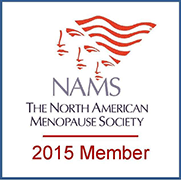Frequently Asked Questions
Many herbal products are being marketed for treating the hot flashes and night sweats associated with perimenopause and menopause. Very few have been proven to be effective. This is partly due to the fact that there have been too few studies and too few people taking part in these studies for the results to be conclusive.
Here is a summary of the benefit and risks of some herbal products commonly used for hot flashes and night sweats:
1. Products with weak evidence of effectiveness
Soy (a phytoestrogen):
• Soy may be effective to reduce hot flashes. Data regarding its benefit are conflicting. Some studies demonstrate modest benefit, while others show no benefit.
In one study, a concentrated soy isoflavone extract of genistein 54 mg daily reduced hot flashes by 22% to 29%.
One study showed that women who experience 4 or fewer hot flashes per day did not benefit from soy supplementation.
• Full effect may take up to 2 months.
• Soy has weak estrogen-like effects therefore is NOT recommended for use in women with a history of breast cancer.
• Recommended dosage: 20-60mg orally daily
• Food forms of soy, like tofu and soy milk, are preferred to supplements.
Black Cohosh (Actaea or Cimicifuga racemosa):
• Black Cohosh may modestly reduce hot flashes. However, there is considerable variability in the preparations used in clinical trials, and in the results obtained.
Seven trials indicated that black cohosh reduced hot flashes by 26% compared to placebo
• Recommended dosage: 20mg orally twice daily
• Onset of symptom relief: 2-4 weeks
• Safety may be a concern as there have been a few reported cases of liver toxicity.
Watch for signs of jaundice or abdominal pain.
• Also may have weak estrogen-like effects therefore NOT recommended for use in women with a history of breast cancer.
• Does NOT seem to be effective for relieving hot flashes in breast cancer survivors.
EPA (Eicosapentaenoic acid):
• Clinical research shows that taking 500 mg orally, three times daily, provides modest, but significant reduction in how often hot flashes occur compared to placebo.
• One study showed the mean number of hot flashes decreased by 1.5 episodes daily in women taking EPA for 8 weeks. However, taking EPA did not significantly decrease the severity of hot flashes or improve overall quality of life.
2. Products with some evidence of possible harm:
Dong Quai (Angelica sinensis):
• Some evidence that it stimulates the growth of breast cancer cells similar to estrogen
• Has not been proven to be effective in reducing hot flashes.
• May contain substances that increase risk of cancer – use is not recommended
DHEA (dehydroepiandrosterone):
• May stimulate the growth of breast cancer cells – do not use if history of breast cancer.
• Has not been proven to be effective
• May cause unwanted cosmetic side effects such as, increase in facial hair, acne, and deepening of the voice
3. Products not recommended because there is not enough evidence of benefit or safety
• Alfalfa (Medicago sativa):
• Chasteberry (Vitex agnus-castus)*
• Evening Primrose Oil (Oenothera biennis)
• Flaxseed (Linum usitatissimum)
• Ginseng (Panax ginseng)
• Hops (Humulus lupulus).
• Kava (kavapyrone)
• Milk Thistle (Silybum marianum)
• Red Clover (Trifolium pratense)
• Royal Jelly (Apis mellifera
• Sage (Salvia officinalis)
• St. John’s Wort (Hypericum perforatum)
• Valerian (Valeriana officinalis)
• Vitamin E (Alpha-tocopherol)
• Wild Yam (Dioscorea alata)
References:
1. Ulbricht K, Basch E, editors. Online Natural Medicines[Internet]. Somerville (MA); c2015 [cited 24 Jun 2015]. Available from: https://naturalmedicines.therapeuticresearch.com Subscription required.
2. Santen R, Loprinzi C, Casper R. Menopausal hot flashes. In: UpToDate, Basow, DS (Ed), UpToDate. Waltham MA, 2015. Cited 30 Jun 2015. Available from www.uptodate.com Subscription and login required.
3. WebMD. Natural Treatments for Menopause Symptoms. [Reviewed 1 Jun 2014; cited 25 Jun 2015.] Available from http://www.webmd.com/menopause/guide/menopause-natural-treatments
4. National Institutes of Health. Menopausal Symptoms and Complementary Health Approaches. [Updated Feb 2012; cited 24 Jun 2015]. Available at https://nccih.nih.gov/health/menopause/menopausesymptoms
5. Canadian Pharmacist’s Letter – Natural Medicines in the Clinical Management of Menopausal Symptoms. Oct 2012; 12(110).
6. Bolaños R, Del Castillo A, Francia J. Soy isoflavones versus placebo in the treatment of climacteric vasomotor symptoms: systematic review and meta-analysis. Menopause. 2010 May-Jun;17(3):660-6.
7. Shams T, Setia MS, Hemmings R, et al. Efficacy of black cohosh-containing preparations on menopausal symptoms: a meta-analysis. Altern Ther Health Med. 2010 Jan-Feb;16(1):36-44.
8. Lucas M, Asselin G, Mérette C, et al. Effects of ethyl-eicosapentaenoic acid omega-3 fatty acid supplementation on hot flashes and quality of life among middle-aged women: a double-blind, placebo-controlled, randomized clinical trial Menopause. 2009 Mar-Apr;16(2):357-66.
Improving Women's Lives Through Better Health in Mid-Life and Beyond


